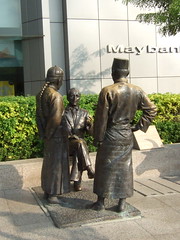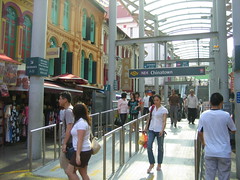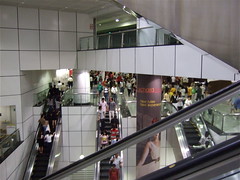Return to Asia Part II: The Riddle of Singapore
After our book launch in Kuala Lumpur, my publisher, Raja, invited us to meet his family at a local Indian restaurant. His sister Gowri, in a peach sari, stood to welcome us as we entered the Bombay Palace restaurant comfortably situated in an old house. We were introduced to his mother who greeted us with the prayer hands held to the face as we do in Thailand. She was dressed in a blue sari and looked about as stern as my grandmother had been. We were soon joined by Han and his father, an economist and long time friend of Raja's.
Conversation drifted from organizational business and social theory to occasional reference to popular movies. My mother was enjoying herself immensely, stimulated by references to cities she had visited and a shared English education, while I fended for myself. Meena, another sister and author, had already been compelled to correct me on the ranking of California as the 8th largest economy in the world, not third. Tut, tut.
I asked Raja what we should see in Singapore. We would not have a book launch in Singapore this time around, but my mother and I still wanted to see it since it was so close. Friends and relatives in Thailand had always told me Singapore was boring (and expensive), but friends in the States rhapsodized about the little city state as one would over San Francisco. Raja wrote down a list of things we shouldn't miss.
The first notable difference about Singapore was that the water was drinkable from the tap. I pointed to the sign over a drinking fountain at the airport upon our arrival. While still in KL, I had caught my mother filling her water bottle from the tap and suspected that it was no more safe to drink than the water in Thailand.
"Even in this luxury hotel?" she asked.
"It's all an illusion," I answered. If Malaysia was anything like the rest of South East Asia, I knew that development had prioritized exports for world trade and disregarded civic niceties. Plus corporate bottling lobbies would probably make sure the water remained unsafe (or if, as in Thailand, the situation improved no one knew about it). I suggested my mother call the front desk.
"Yes you can drink after boiling for ten minutes," said the operator hanging up abruptly.
Singapore was going to be an easy city, I sensed, and upon reaching the hotel promptly crashed. I was sleep deprived from the excitement of preparing for my book launch and we hadn't eaten a proper lunch that day. I could hardly navigate my way out the hotel door to find food and had become brisk and cranky. Luckily a whole block of restaurants awaited us just around the corner. My mother picked one and shepherded me into a seat for pizza and Pellegrino. Pellegrino, she decided, would be her drink of choice in Asia. She also sensed the ease of Singapore and immediately wanted to live there stimulated by the mix of cultures and the stylish blending of old colonial charm with modern amenities.
Refreshed, we set out the next day to explore. The Singaporeans were very friendly and eager to show off their English, which was the language of business, although most spoke Chinese or Malay at home. (The Chinese are the majority of the population with an Indian and Malay minority.) A Chinese lady going to church showed us which bus to catch and what coins to use and soon we were on a double-decker bus headed into the Indian part of town.
After walking briefly we came to Mustafa's, a huge department store which Raja had mentioned because it was crammed with goods that ordinary people actually buy. I was confident that we would escape designer label boutiques and catch a glimpse of real people.
I was immediately dazzled by the fabric section, which overwhelmed even my mother, stacked as it was to the ceiling with batik and saris. I picked out several sarongs before heading to other floors. The luggage department was bigger than any I'd ever seen and I offered my mother my professional services, as an organizer, to help her pick-out a travel handbag and carry-on. The ones she had traveled with so far were clearly inadequate and seeing her rummage through them looking for things was driving me crazy. (I had already offered to take charge of her passport and boarding pass as my travel shirt was basically a filing cabinet.)
It did not take us long to find a knock-off designer suitcase with wheels in an adorable size, then a smart looking purse that had pockets for every item. I showed her how to dangle the leash of her camera outside of the zippered compartment for easy access. Then we headed for the department of international chocolates.
We rolled around the rest of the city filling the little case with our purchases from the tourist bazaars in Chinatown. My map was worn to shreds by the end of the day, but I managed to get us to the riverside by the late afternoon where we enjoyed a delightful (but expensive) pedicab ride from an old guy who described to us all the notable monuments in brisk English before taking us to the famous Raffles hotel.
The charming statues that were distributed along the riverbank depicted scenes from the early days of colonization. I was struck by one showing a white man seated and pontificating to two men standing, one a Chinese man with a queue and the other a Malay in his pill box hat and sarong. The white man was identified by his name and was a Scotsman. He was described as mediating between the other two who were only identified by race. There was a smugness to this scene of a white man telling brown people how to behave that irked me just as there was a smugness to Singapore in all its tidiness.
I could see what my Asian based friends meant when they said that the city lacked sex appeal. Singapore felt more like an arranged marriage between the British sense of orderliness and the Asian entrepreneurial exuberance.
I had had some experience of this British directed sensibility. My book had been produced by an award-winning design firm, based in Singapore. The art director, Andrew, was a personable Englishman who charmed me immediately by complementing me on my writing ability. Our conference calls were accompanied by a staff of Chinese sounding names, women mostly who rarely spoke. We were getting along swimmingly until the day we set out to discuss what scenes of the book should be illustrated.
The most dramatic part of the book involved a séance with a homemade Quijia board, which was how my mother had described it. The game also had a Thai name which translates roughly to Spirit of the Glass in which a spirit is summoned and questions are asked. It was a pivotal scene and, I felt, an obvious one to illustrate. As I described the event Andrew stopped me and said that, as a Christian, he objected to the use of the occult and he wouldn't want to subject his staff, some of whom were Muslim, to having to work with such material either. Nor did he recommend that his clients use any symbols that might be found objectionable by religious groups.
I was so stunned by the raising of religious issues in a business context, not to mention an artistic one, I felt out of my depth to defend myself. I had no feel for what it was like to live with such clear divisions of ethnic and religious boundaries. If the way to maintain peace in Malaysia was to carefully erase anything that might offend, then I would have to live with it. In the end, the illustration we settled on was a lie. It substituted the homemade letters and glass for a table flying over the heads of the participants. This never actually occurred (though it did seem to capture the spirit of the event).
The discussion raised an obvious question for me. How did such easily offended religious people, including this art director, feel about an author who was openly gay? No one on the design committee seemed to care about that or any text I penned as long as the graphics weren't controversial, so I never brought it up.
When I was interviewed, by the two reporters in KL, I did wonder if an openly gay author was unusual in Malaysia if less so in Singapore. When the piece came out in the Sun, it pointedly mentioned my homosexuality as one of the skeletons in my family closet, even though my book had almost no gay content and what was there was about identity and was hardly a revelation.
"It makes the book seem racier than it is," commented Han when he sent me the article.
I chuckled the whole way through reading it feeling a bit scandalized myself seeing how I looked in the context of Asia. I had been sensationalized into a passionate truth-telling, lesbian doomer, describing how being gay was the source of my motivation to write freely while nothing at all was mentioned about my quest to understand my biracial and cultural heritage—the real motivation for my writing the book. The reporter did seem to admire my determination to be my own person so I forgave him missing the story of the book.
The Muslim presence in KL and Singapore, graphically illustrated by the head to toe black burkah, did speak volumes about the choices some Malaysian women had made regarding freedom of expression. The reporter had picked out the most "American" aspects of my life from my non-academic career as a professional organizer and handywoman to my desire to be "free of societies expectations" by coming out so young as a gay person. In the context of the goal of Asian people to blend into the identity of the group, preferably at the highest status possible, my quest to tell all, despite possibly bringing shame to my family, would be as exotic as their burkahs were to me. My quest to understand cultural differences and learn where I belonged in the world was not nearly as compelling even as a person of a mixed marriage.
Our taxi driver to the airport was eager to expound on how there was no racism in Singapore because they had all gone to school together. I had heard the same from a Chinese friend from high school now living in Singapore.
Walking through the city I could see why it would be such a pleasure for my American friends doing business here. All the rules were cut and dry and well enforced. Much effort had been put into a homogenous and well-run infrastructure. Civic life and public space blended seamlessly into private enterprise. Plus Singapore was considered one of the safest cities in Asia.
Economic stability for the majority, I felt, was the key to such civility. Journalists, eager to pinpoint ethnic violence inspired by religious fundamentalism, all but ignore details of economic injustice. I had learned to be suspicious of any headline calling attention to ethnic strife. If the journalist had any integrity at all, deep in his article I would find references to a factory closure causing a strike that pitted one group against another or government mismanagement leading to one ethnicity being favored over another.
Singapore had attempted to raise all boats with government subsidized housing wiping out old neighborhoods that might be considered poor. Gone with them were the old communities in favor of high-rise "pigeon hole" apartments.
The emphasis on public civility has been made famous by the caning incident. There were even tourist T-shirts sharing the joke along the lines of "I went to Singapore and all I got was a lousy caning".
When I came upon a sign forbidding the riding of a bicycle through a pedestrian underpass with a fine of 1,000 Singapore dollars I understood the effectiveness of stiff punishment. It made me nervous that I might inadvertently trigger some fine, jaywalking or something. I was happy to be returning to the relative chaos of Bangkok. There was something a little too perfect about Singapore.
Singapore set an example that Bangkok seemed to aspire to. The new underground train in Bangkok was exactly the same design as the one in Singapore and I saw signs promising stiff fines for smoking in restaurants and drinking alcohol in the civil registry office, but somehow those prohibitions seemed appropriate. Bangkok needed a few more restrictions while Singapore gave me the sense that nothing unexpected could be allowed to happen.
That, perhaps, was it's missing sex appeal.
Labels: bicultural perspective, race, singapore, travel









5 Comments:
I felt very similar to you about Singapore, although it's quite a few years since I spent time there. One thing I noticed was a lack of art as a source of identity, other than what was officially sanctioned, which seemed very thin. I spent some time in hospital there (Gleneagles, which was very swish) and met the 'top end of town' too.
It's a system which has bought in to Western industrialism and consumerism at every level and so it will be interesting to see how the coming decline will be dealt with.
Yes I couldn't help noticing that Singapore was completely invested in a petroleum based, consumer society with more growth expected given the many high rises under construction. And with the population so conforming and so closely watched, it's hard to imagine any alternative solutions being available for a decline in industrial activity. Just severe rationing. Thanks for sharing your impressions Lloyd.
Raja's sister's name is Gowri, btw.
Thanks Han. Fixed it. I knew you could help me with that.
I take issue with Lloyd's comment that art is not a source of identity in Singapore. The Singapore government is much more complicit in arts production than the Malaysian one. While we struggle to put together a consensus to even have an arts council, Singapore's National Arts Council has been bringing in some top arts practitioners for years now.
Last year, I went down twice last year to check out arts festivals and the international fare blew me away.
Which is all to say that arts CAN be a source of identity if a young man, woman, f-t-m or m-t-f transsexual, etc. so chooses.
Post a Comment
<< Home